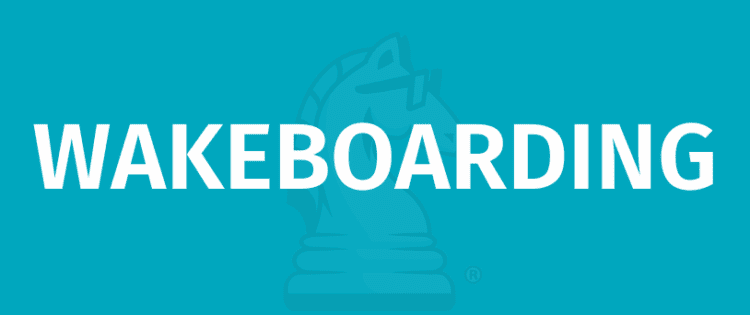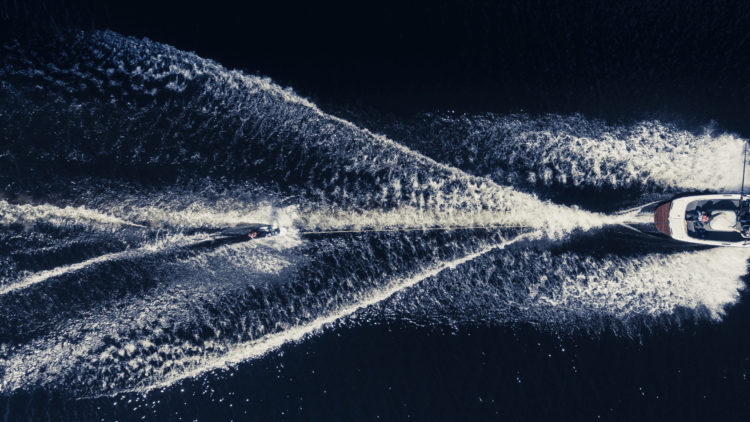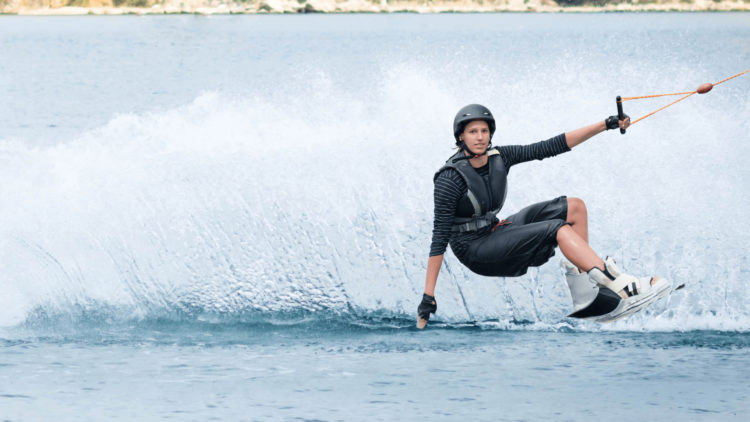
OBJECTIVE OF WAKEBOARDING: Get the most points by performing tricks on a wakeboard while riding through the crest of the motorboat’s wake.
NUMBER OF PLAYERS: 2+ players
MATERIALS: Wakeboard, boat, bindings, tow rope, life jacket
TYPE OF GAME: Sport
AUDIENCE: 8+
OVERVIEW OF WAKEBOARDING
Wakeboarding developed as a more extreme form of waterskiing during the 20th century. In 1985, a special board with foot straps was designed in Australia specifically for performing tricks. It was called a “skurfboard,” but the name soon changed to wakeboard, and since then, wakeboarding competitions have taken place all over the world, including at the X Games.
SETUP

Wakeboarding can take place on any area of flat water, such as lakes and rivers, even flooded areas of land can be used for more informal wakeboarding.
The wakeboarder starts in the water with their feet connected to the board with bindings or straps, using their hands to hold the tow rope, which is attached to the back of the motor boat. The rope’s length can vary between 55 and 75 feet.
The boat begins to move and pick up speed, hitting around 25 miles per hour. Such speeds create a clear, firm wake – a trail of white water behind the boat. The wakeboarder then moves across the wake from side to side.
Two inflatable buoys mark the course, 5-10 meters (16.4-32.8 feet) apart to create a start line and two more to create a finish line. The course is between 375 and 400 meters (1230 and 1312 feet) in length.
GAMEPLAY
In competitions, wakeboarders take turns riding the course. Each participant has two passes at the course, during which they perform a set routine of tricks. Their first trick must be performed after crossing the start line, and the last trick must be completed before the finish line. If a competitor falls more than once, their pass is over.
Tricks are judged on three criteria: execution, intensity, and composition. Cleanly performed tricks with plenty of air will gain more points, while more points are available for tricks of greater difficulty. The scores from the two passes are combined to give each competitor their total score.
COMMON TRICKS

Here are some common tricks wakeboarders will perform during their passes.
GRABS
As the name suggests, grabs are tricks where the wakeboarder uses one hand to grab a specific part of their board. For example, a nose grab involves holding the front of the board, while tail grabs are when one holds the back of the board. Some grabs have less obvious names, such as the melon grab, where one hand grabs the heelside edge of the board by reaching down between the bindings.
SPINS
Referred to by how many degrees the rider rotates on their board, such as a 180, 360, 540, or even 720. In addition, the direction of the spin or position of the hands can make a spin more specific. An example of a spin is the whirlybird 540, where the rider performs a 540-degree backspin with the rope handle rotated above their head.
ROLLS AND FLIPS
A front or back flip in wakeboarding is like a cartwheel, where the board and rider flip over in a circular motion. Rolls are a type of flip, but they add different spins and turns as the board rotates.
JUDGING
Each competition under International Waterski and Wakeboard Federation Rules has three judges. Each judge awards a score out of ten for the three criteria: execution, intensity, and composition. Then the average score of each criterion is calculated.
The averages for execution and composition are then multiplied by 3.3, and 3.4 for intensity. Finally, the three numbers are added together to give the final total. The maximum a competitor can score is 100 points.
END OF GAME
The event ends once all competitors have completed their two passes and all scores have been confirmed. The wakeboarder who has secured the most points is the winner.
- 30 GAMES TO PLAY OVER TEXT - April 22, 2024
- 20+ FREE PRINTABLE BABY SHOWER GAMES - April 16, 2024
- 20+ College Party Games for the Best Night Ever! - April 2, 2024